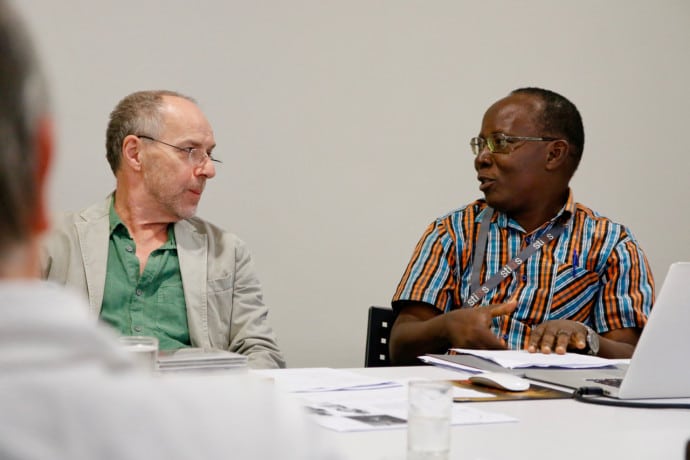“We have many things in common as composers but we also diverge,” said Justinian Tamusuza. “We are both interested in the coming together of Western and ethnic African music. We have both worked with Western ensembles and studied Western theory, and one of our first influences was church music. We speak the same musical language.”
“Justinian grew up with traditional music. He played the instruments and was immersed in the traditions from a young age,” added Michael Blake. “Traditional music was not initially part of my training and instrumental composition. I chose to incorporate it into my work. Justinian is influenced by theatre, dance and drama. I’m more influenced by the visual arts, literature and film.”

Composers Blake, who is currently a member of the Africa Open Institute at Stellenbosch University and Tamusuza who is based at the Department of Performing Arts and Film (PAF) at Makerere University, are currently in residence at STIAS.
Although coming from different starting points, both Blake and Tamusuza bring together influences from ethnic or traditional music and western classical music styles into their compositions and teaching. Born in Cape Town, Blake studied classical music at the University of the Witwatersrand, Goldsmiths College London, and at numerous composition master classes. Since the mid-1970s he has engaged with some of the traditional music of South Africa, notably Xhosa bow music and overtone singing from the Eastern Cape. Tamusuza first learnt traditional Ganda music in Uganda and continues to practice and teach Ganda music composition at Makerere University. He studied western classical music at Makerere University, at Queen’s University, Belfast where “I had to talk the authorities into allowing me to study ethnic music”, and at Northwestern University, Illinois.
In a rich seminar interspersed with audio examples from traditional music, as well as some of their compositions for string quartet (including Tamusuza’s composition for Pieces of Africa which topped the US CD charts), Blake and Tamusuza explained the overall differences in techniques between Western and traditional African music and their experiences of merging the two.
“The idea of using traditional music in Western compositions is not new,” said Blake. “It is seen to some extent in the works of Dvořák, Mozart, Brahms and others.”
“A composer’s musical voice is influenced by their home background, cultural music practices, education, the schools and institutions they attend, their teachers, their thinking and interests, their friends, the work they do, their personal character – the list continues,” said Tamusuza. “But even if two composers grow up in the same environment, their musical language will not necessarily be the same; the way they express themselves in their music is, in most cases, quite unique.”
Marriage of cultures
“I experience contemporary art music as a marriage of two musical cultures, Kiganda of the Baganda in Uganda and the western art music, which have shaped my musical performance and creativity for the last 40 years,” said Tamusuza. “The materials you work with depend on the music you want to make. I make Western instruments speak my language.”
Blake described the major turning point in his work as the opportunity to hear his first traditional bow player in Grahamstown. “Nofinishi Dywili was an expert player of the Uhadi bow,” he said, “truly a master musician. She was part of a traditional group that also specialised in overtone singing. They came from a desperately poor rural area but eventually did concert tours throughout the world supporting their community along the way. I call it my ‘Damascus Road’ experience because it profoundly influenced the direction of my work from there on.”
Blake and Tamusuza described African traditional music as having specific characteristics – often a descending melody, a 5, 6 or 7-note scale and usually a more cyclical, repetitive structure compared to more linear Western classical music. “But it is the rhythm that is the most sophisticated characteristic of traditional music and definitely influences what I do,” said Blake. “Somewhere in the texture of all my music are these rhythms and textures.”
“Xhosa musicians also talk about ‘putting the salt into the songs’ using added notes, variations and handclaps,” he added.
“It’s sometimes a challenge to create continuity whilst including the spice,” added Tamusuza.
“To some extent it’s about merging Western individuality with African collectiveness,” said Blake.
“It’s also about using intonation to enhance meaning,” added Tamusuza. “Just like in spoken language, in music you need to take care of the intonation or you can cause confusion.”
In discussion the two addressed the issue of cultural appropriation. Tamusuza said: “I don’t care about appropriation or being accused of speaking in colonial language as long as my music communicates my message. I use Western instruments and idioms to communicate to my satisfaction.”
“The younger generation of composers are not interested in traditional music, they want to be global,” added Blake. “I originally dabbled in different styles and influences while looking for my voice. I found indigenous music fired me up. I wouldn’t be sitting here without African music. I created music by synthesising different music traditions. I guess I am guilty of cultural appropriation but it works for me.”
“It’s important though that we stop feeling we have to always reach back to Europe or America. Younger black composers still feel they have to. I would encourage responsive and in-depth engagement with many traditional music sources.”
During his time at STIAS, Blake will work on a composition treatise which draws on his earlier publication Afrikosmos which is a course of study for pianists and a compendium of composition techniques synthesising traditional African and Western art music.
Tamusuza will complete a vocal art work entitled: Ggwe Tulinda Atutuuseeko (The Messiah we have been waiting for has arrived).
Tamusuza and Blake also premiered their latest work entitled: Nakutendanga Emirembe Gyonna (I will praise you (God) forever) (Tamusuza) and Umngqokolo (Blake) in Riebeek Kasteel on 27 January.
Michelle Galloway: Part-time media officer at STIAS
Photograph: Christoff Pauw
